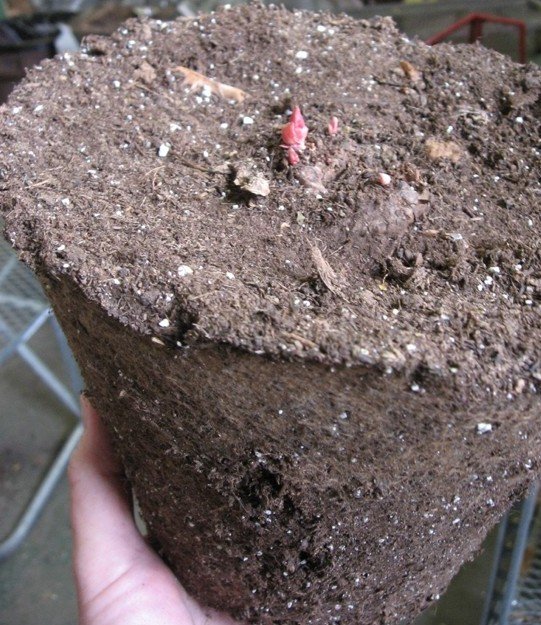
It seems a shame, but tuberous begonias are often flowering at their best in late summer, just when it’s time to bring them indoors. Like most bulbs, tuberous begonias need a period of dormancy – several months where it’s dry, dark and cool. My bulbs spend the winter in a dark corner of our basement. I discovered my storage trick by trial and error over the many, many years I’ve enjoyed these amazingly floriferous plants. It’s actually super simple.
It’s best if they first get nipped by frost. Wilted foliage is fine, but the the most important thing is to not let them freeze. Better to bring them in a little early. This tells the tubers it’s time to go dormant.
Be gentle with them at this time of year as their fragile, water-filled stems and swollen tubers are easily damaged. Begonia tubers have thin skins and a tiny nick or scrape can become an entry point for infection that will rot your tuber; minimal handling is best. Bring them inside, pot and all, if they’re potted. If you planted them in the garden, leave as much of the root ball as you can manage. Cut the plants back a bit if they’re huge, but try to leave as much growth as you can.
Leave potted begonias in their pots. Those planted in the garden can be carefully cleaned of their surrounding soil and stored in dry vermiculite, sawdust or peat moss in open paper bags. A cool, dark spot is best. Now you let them dry out, and then remove the stem and foliage. By leaving your tuber unmolested, it can dry (ripen) slowly, forming the thicker skin that helps it retain the moisture it’ll need when it begins to sprout again.
Our modern, thermally efficient accommodations tend to be extremely dry in winter. Indoor humidity varies so check on your tubers from time to time. Give your potted tubers a bit of water if they’re starting to shrivel. Bagged tubers can be removed from their bags (media and all) and given a light misting of water.
Another good reason for these checkups is that your begonias may well start to wake up in February or March which is a good thing. I’ve all too often heard sad stories from begonia lovers with neglected tubers that have grown tall, thin white stems while in storage. This won’t kill them, but will give a poor performance that summer. An early awakening tuber can be restarted early indoors. Remember, with tuberous begonias, the earlier they start the sooner they’ll commence their superb, summer-long display. Besides, aren’t we all dying to get something growing in the depths of winter?
By now some of you may be wondering if this is worth all the bother. Well, you’ll know if your begonias were properly grown if the tuber is larger at the end of the season than when you started. If not, then they were missing something they need. An important lesson that, if acted upon, will make you a better gardener. If it has grown bigger it may be big enough to divide into two. Even an undivided tuber will produce a larger plant with more flowers. Like potatoes, begonias grow from tubers, can be divided provided each piece has an “eye”.
More on tuberous begonias

Thank you for this helpful article. Most places on the web suggest digging up the tubers and storing them in peat moss or vermiculite. I’m happy to hear that I can keep them in their pots. I bought some trailing tuberous begonias this year and am hoping they’ll come back. Any tips for helping them wake up early and not, say, August? I have some tuberous begonias potted with ivy that I bring indoors at frost time each year. The tubers don’t get a chance to dry out because I still water the ivy all winter. The begonia starts waking up in August each year. I’d like to help it wake up earlier! Thanks for your time.
Great to see the articles by Dugald Cameron, a good deal of very useful information was given in the article about peonies so I was glad to see the new one on begonias. Dugald is a clear, practical writer so even though we cannot enjoy his bulbs etc. he is an excellent source of garden ideas and advice – a credit to your magazine. JW
What fantastic advice. I have been growing and storing begonia for years but had no idea you could divide the larger tubers. Thank you!
Thank you for the good information on tuberous begonias.
Now can we learn how to store fibrous begonias. please. Thanks, Jane
Hi Sulta:
Fibrous begonias don’t grow from tubers. As their name suggests, they’re fibrous rooted. They’re most often treated as annuals that can easily be grown from seed indoors in early winter.